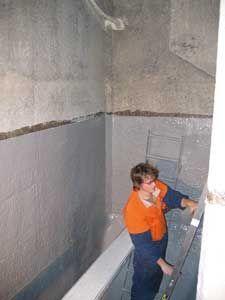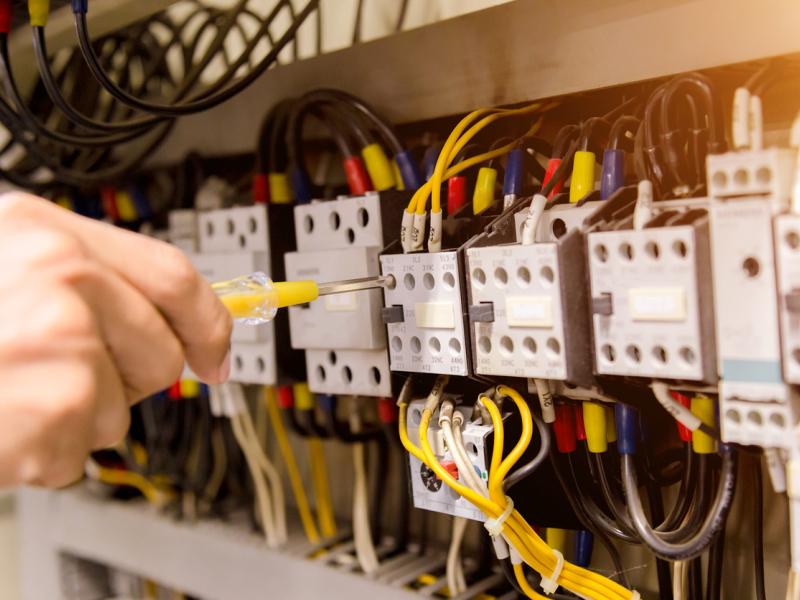The North Shore City Council (NSCC) recently refurbished two 45-year-old concrete wet wells at Pumping Station 2, Seabreeze, in Devonport. The project was part of the Council’s ongoing routine public infrastructure maintenance program. The $150,000 project had three main components. The first was to implement bypass arrangements to prevent sewage overflows and ensure uninterrupted sewage services to more than 10,000 households using the wet wells. The second was emptying, sanitising, and cleaning the wet wells, and the third repairing the wet well surfaces and replacing the access structures. Albany-based Markplan Consulting, a specialist civil and structural engineering company, acted as project supervisor and quality controller for the NSCC. Nukote Asia Pacific, Glenfield Coating Services, and East Coast Bays Engineering were the main contractors. The construction teams moved onto the site on June 22, 2008, and handed back the refurbished, live wet wells to the Council just nine days later on July 1. Markplan Consulting did the initial investigation and inspection of the wet wells, including a report with recommendations on the work to be done. Its scope of work on the Seabreeze project also included preparing the tender on a measure and value basis, managing the project, including liaison with the contractors and site supervision and safety, measuring the work done, furnishing the practical completion certificate and sign-off, and processing progress payment for the contractors and NSCC. According to Markplan Projects supervisor Stuart Knox the project posed several challenges: “The biggest was to bypass the live wet wells for longer than a week during the winter’s particularly wet conditions, and implementing suitable controls including 24 hour pump monitoring during this period. “Then we had the issue of working in a confined space, and repairing the damage to the concrete with a best practice regime within a tight timeframe. The NSCC’s expectations, especially around safety issues, are very high,” he says. Knox explains why the wells needed refurbishment and the reasons for the repair protocols. At 3.8 metres wide by 1.5 metres long by 3.8 metres high each, the wells are located six metres below ground level in the pumping station on the corner of Seabreeze Road and Lake Road. Maintenance and inspection workers access the wells by a staircase to a grid inspection floor, about 1.9 metres up from the floor of the concrete tank and with around 0.4 metres clearance between the sewage and the inspection floor under normal flow conditions. The two wet wells in Seabreeze put through on average 2,500 cubic metres of sewage per day. From there three Pumpex K156 pumps send the sewage to Northboro pumping station. Northboro receives sewage from another five local pump stations and in turn pumps the sewage to Barry’s Point pumping station. NSCC monitors the operation via a SCADA system and some real time control between stations. Raw sewage consists of household kitchen and bathroom wastewater. It contains detergent, food particles, human excreta, and human sebum. This mixture has a destructive effect on the surface of the wet wells both under and above the waterline. Nukote Asia Pacific Australasia general manager Alan Gow says the wet well was typical of many wet wells constructed during the previous century. “Years of constant exposure to corrosive liquids and gases had severely degraded the concrete surface, threatening the long term life of this vital asset. “But the system was well-designed with good venting, so the upper surfaces showed less damage. Even so it’s important to arrest all decay before it exposes the concrete’s reinforcement and or penetrates deeply into the concrete, as both cause significant structural damage requiring a costly replacement,” he says. Knox advised dividing the interior into two sections for repair. Nukote, from Takanini, repaired the floor and walls to a height of 3.8 metres with a modified polyurea coating formulated to withstand wastewater conditions. Wairau-based Glenfield Coating Services repaired the rest of the walls and ceiling with a high-strength industrial paint. Bypass pumping Before the refurbishing work could commence, the pump station had to shut down. This involved diverting the incoming sewage and emptying and sanitising the wet wells. Nukote appointed Transpacific Industries Group (NZ) as its subcontractor. The Transpacific crew started bypass pumping from a manhole located upstream from the wet wells, using two mobile Selwood S150 self priming pumps, via a 100 metre-long hose running above ground to the highest point of the rising main. A third pump remained on standby throughout the eight days of bypass pumping and kicked in during peak flow periods. Another pump was kept ready at the pump supplier’s yard to be delivered in case of an emergency. Next, the crew emptied the wet wells into the same bypass system. The workers installed a pneumatic plug at the wet well entry point in the inlet pipe behind the penstock gate, gaining entry via the manhole. The gate had to remain closed throughout the operation to ensure there would be no movement of the plug. Once the wet wells were secure, the crew mobilised an HD174 waterblaster to clean the interior from the top downwards of organic contaminants, grime, previous coatings, and degraded concrete. The 40,000psi at low flow setting cleaned the surfaces and opened all bug holes, voids, and undercuts without damaging the surfaces further. NSCC maintenance contractor North Shore Services then removed all conduits, access structures, piping, and plant. Transpacific applied Nukote’s degreasing solution and hosed it off to remove the last traces of grime. A suction truck removed the cleaning water and solids to an approved dump. Primed and protected Following Nukote’s recommended procedures, the Nukote-Transpacific team prepared termination points, chase cuts and other ancillary items, then primed the surface to be recoated first with Nukote HLT Hydro Lock Treatment and then a coat of Nukote ECS 100-percent polyamine epoxy primer. Gow decided to apply the Hydro Lock to minimise pinholes and stop any hydrostatic pressure. The Nukote ECS epoxy primer, applied at 100 microns and back rolled thoroughly into the substrate, penetrated deeply into and further strengthened the concrete substrate to enhance the overall bond strength. Gow says Nukote ECS primer has been proven in numerous applications to provide an “excellent bond between the concrete and Nukote polyurea.” The team then applied Nukote XT (Extreme Conditions) modified polyurea in two coats at total film thickness of 5mm. The two coats were tinted in contrasting colours to allow for effective 100 percent visual inspection after each coat. Explains Gow: “The fast gel and spray application of Nukote polyurea allowed the coating to fill in the surface defects without traditional additional surface preparation work such as epoxy or mortar filling. It left a smooth surface following the contours of the substrate. “Surface depressions and features indicating defects in the concrete remained, but past experience demonstrates that rag and other solids do not build up or accumulate on these features. In addition, this is a fast-dry product, an important advantage given the cost of the bypass pumping. “We’ve effectively installed a ‘spray-in’ liner rather than a concrete coating. This liner is chemically resistant, incredibly tough, flexible, seamless and securely bonded to the substrate,” he says. The Nukote team completed its work on June 26, and Knox and Gow did a three-step process inspection to confirm the integrity of the coating. In the meantime, Albany-based East Coast Bays Engineering had measured up the space for new access platforms, consisting of 316-stainless steel angles to form the floor frame, the floor itself, and 316-stainless steel handrails. Workshop manager Peter Lee opted to make the floor from 38mm glass-reinforced plastic, supplied by Palmerston North company Webforge. “This is a particularly strong material and well suited to resist the corrosive environment,” he says. It took the ECB team 11 days to make the support structure, and five days to fit the well. Glenfield Coating Services (GCS) could now complete the next stage of the repair work, laying down four coats of two-pack epoxy Resene paint. Owner Craig McLeish says he chose the paint because it is chemical and solvent resistant and designed for harsh environments, but rapid drying. Although the three-strong GCS team has worked in confined areas before, McLeish says doing so at this level meant the six days it took to complete the job was indeed a learning curve. The high film build paint is a spray-apply formula, and to prevent build-up of pockets of explosive gas the space required thorough ventilation. North Shore Refrigeration and Air Conditioning, based in Albany, calculated and maintained the required flow rates. “The NSCC has very strict safety requirements. We had to retrain to work in confined areas and remove an unconscious person from such an area. The team worked in full respirator gear with gas monitors with one member dedicated to monitoring gas levels – altogether a challenging experience,” McLeish says. Transpacific removed the bypass and handed the wet wells back on July 2. During the bypass period, the Transpacific team provided round the clock pump monitoring and site security for the pumping areas and bypass pipe. Knox did the final inspection of the refurbished well and signed off the Practical Completion Certificate on July 29. NSCC project engineer Mahinda Attanayake, who managed the project, says this is the first of eight wet wells identified for refurbishments. “One of the important features for the success of the project was the around the clock communication and coordination between operations and projects personnel,” he comments. Jenny Baker is an Auckland-based freelance writer.•
Good for another half century
General
Wednesday, 14 January 2009






